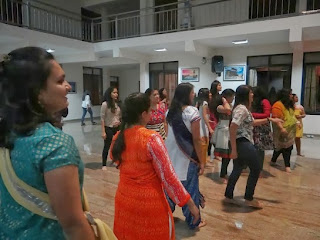Navarātrī
celebrations, at Good Shepherd Finishing School started on 5 October, 2013, with the
girls donning their traditional attire and getting ready to do the Garbha, a traditional
folk dance of Gujarat. As the girls danced gracefully one rhythm after the
other in concentric circles, they were joined by the members of the faculty. Such was their enthusiasm. “Why Garbha?”, some may ask. Traditionally,
Garbha is one of the dances performed on all days during the nine-days of the Navarātrī
festival. The word Garbha comes from the Sanskrit word for womb and so implies the birth of a new life. The
dance is performed around a clay lantern with a light inside, which represents
life; the child in the womb in particular. The dancers thus honor Durga, the feminine form of divinity. The rings of dancers
revolve in rhythmic cycles, which represents the rhythm of Time. As the cycle
of time revolves, from birth to death and again to rebirth, the only
thing that is constant, according to beliefs is the Goddess, that one unmoving
symbol in the midst of all of this unending and infinite movement. The dance
symbolizes that God, represented in feminine form in this case, is the only
thing that remains unchanging in a constantly changing universe.
At GSFS, we watched as 66 incarnations of Goddess Durga
descended to Earth to welcome Navarātrī
dancing away to eternity…



